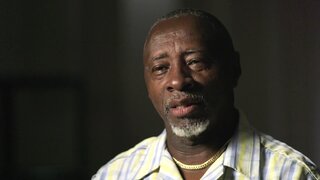Create a free profile to get unlimited access to exclusive videos, breaking news, sweepstakes, and more!
Man's Secret Identity Exposed After He Viciously Attacked Alabama Mom
When Lisa Nichols was shot to death and then set on fire, investigators soon realized someone living near her home was to blame.
Small-town Chunchula, Alabama residents are used to dealing with the chaos of hurricanes. But they were unprepared for the shocking fallout from the murder of a local woman working to build a better life for herself.
In the wake of Hurricane Ivan, 44-year-old Lisa Nichols was found dead in her mobile home on September 18, 2004, according to legal documents. There had been a fire, which initially appeared to have been a tragic accident.
But when first responders moved her charred body, a strong odor of gasoline suggested the blaze was intentional, investigators told “Floribama Murders,” airing Saturdays at 9/8c on Oxygen.
“You’ve got a monster who took her life,” said Capt. Paul Burch, Mobile County Sheriff’s Office.
About 12 hours into the investigation, the Mobile County, Alabama coroner determined that Nichols had been shot in the head before the fire. Who was responsible?
Investigators learned that Nichols had been discovered by her son-in-law and two daughters, who’d come to check on her following the storm. Because they had no cell service, they called 911 from the home of Nichols’ neighbor, Mark Bentley.
Bentley and his houseguest, Scooter Coleman, ran to Nichols’ trailer to try to help, but a third man, later identified as John Paul Chapman, didn’t budge, according to the Nichols’ daughters.
Detectives searched the crime scene, and while collecting evidence, they discovered there were two types of beer cans in the home. Ones in the sink had been drained and crushed, others were left intact. They determined that Nichols had drunk from cans in the sink, and ones on the floor were believed to be from the suspect.
The cans were sent out for forensic analysis.
Officials spoke with Bentley, who was in the construction business, but he was cleared as a suspect; investigators said he “was clearly shaken” by the murder. Plus, he had an alibi: On September 15, as the hurricane was bearing down on the area, Bentley and his family left for Chickasaw, Alabama, according to legal documents.
Meanwhile, Coleman and Chapman, who worked on-and-off for Bentley, had stayed behind to take care of the home. Could they have been involved?
RELATED: Pushy Ghosts, Wailing Babies, Haunted Bridges: Eerie Urban Legends Of Florida And Alabama
Coleman told investigators that he’d seen Chapman going through a closet in Bentley’s bedroom. Chapman claimed to be searching for a radio, according to Coleman, but he said he saw that Chapman had a pistol in his hand, according to “Floribama Murders.”
Coleman later found Bentley’s gun back in the closet. Investigators collected the gun as evidence, along with Chapman’s clothes left at Bentley’s home.
Investigators wanted to speak with Chapman as well, yet he was nowhere to be found. Then, Chapman made an unexpected call to Sgt. Mitch McRae, now a retired member of the Mobile County Sheriff’s Office, promising to come in for an interview — but he never showed up.
“Obviously that was a flag going up,” said McRae. “He was acting pretty guilty.”
In a surprise twist involving an alleged methamphetamines theft, investigators located Chapman’s vehicle and had it towed. McRae subsequently tracked down Chapman. Chapman also had an outstanding warrant for failing to appear in court in Douglasville, Georgia, so Alabama officials took him into custody.
Chapman reluctantly told investigators that he had gone to Nichols’ home at her invitation. He claimed that he stood on the back porch but never went in, according to detectives.
As the interview continued, though, Chapman changed his story. He claimed that Nichols wanted to buy crystal meth. After getting high together, they had sex, Chapman claimed. Chapman then alleged that Nichols OD’d, and he feared being blamed for her death, so he got Bentley’s gun and shot her. Then, he set the fire.
Investigators knew Chapman was fabricating stories out of lies and half-truths.
“There was never any indication from anything that Lisa had any involvement in drugs,” said Burch.
During the interview, Chapman used an investigator’s phone to call his girlfriend, who lived in Georgia. She never picked up. The detective called her the next day in hopes of getting information. When investigators told her that Chapman was in jail, her response floored them. She told them she suspected that he’d killed her 16-year-old neighbor, Amanda Greenwell.
Greenwell went missing in March 2004. Her body was found six months later. She had been beaten and raped, and her neck was broken. The case was still unsolved. Alabama investigators realized that they could be dealing with a serial killer.
In an attempt to get more of a confession, investigators told Chapman that his fingerprints had been lifted from beer cans inside Nichols’ home. It worked. Chapman came clean about what happened.
“He told us when he first went over there she wouldn’t let him inside,” said investigators. Once inside, he raped her, saying that “she fought like a wildcat, so I killed the bitch," according to investigators.
Chapman was charged with murder. In light of the Greenwell case, detectives contacted law enforcement agencies outside their jurisdiction to see if Chapman could be tied to other investigations.
That led Mobile County, Alabama officials to the shocking discovery that their suspect wasn’t who he said he was: John Paul Chapman was actually behind bars in Missouri. Their suspect was a man named Jeremy Jones.
Chapman’s mother had sold her son’s social security card and driver’s license to Jones for around $50, according to “Floribama Murders.” In January 2004, a then-32-year-old Jones said his name was John Paul Chapman when he was arrested on trespassing charges outside Atlanta, according to the Los Angeles Times.
“The FBI then ran his fingerprints through the Integrated Automated Fingerprint Identification System, or IAFIS,” the LA Times reported. “But the system did not connect the prints with earlier prints from Jones.”
Because there were two sets of fingerprints on file it was impossible to connect Jones with Chapman. That devastated Lisa Nichols’ family, according to “Floribama Murders.”
Still, investigators continued to build the Nichols case. The gun Jones took from Bentley’s closet was found to be the one that killed Nichols. DNA evidence from his clothes matched Nichols. In a recorded jailhouse telephone conversation with Bentley, Jones essentially confessed to killing Nichols.
It was enough to convince a jury. Jones was found guilty of murdering Lisa Nicholas and was sentenced to death. He currently sits on death row awaiting an execution date.
The FBI later issued a statement and apology to the family about errors made in the fingerprinting process during Chapman’s arrest in Georgia.
Since Jones' conviction, he has has been linked to three other murders in Kansas, Louisiana, and Georgia, including Amanda Greenwell and Katherine Collins, according to “Floribama Murders.” Due to a lack of physical evidence, those cases have never been brought to trial.
To learn more about the case, watch “Floribama Murders,” airing Saturdays at 9/8c on Oxygen. You can stream episodes here.























